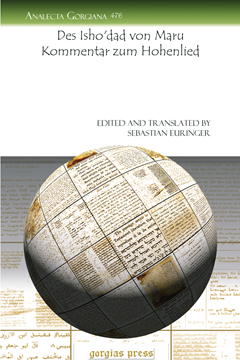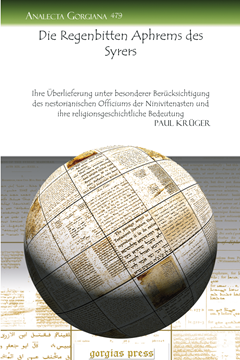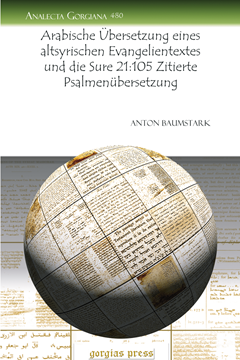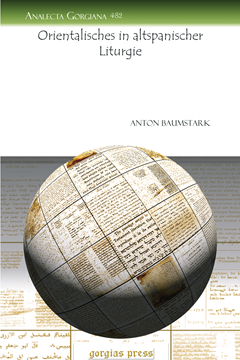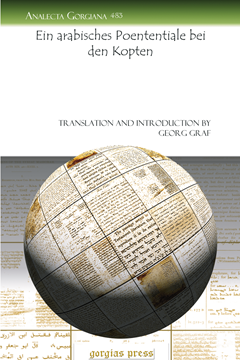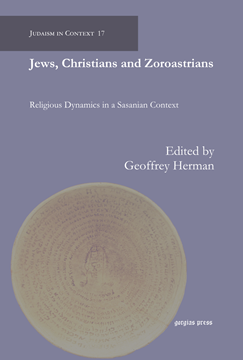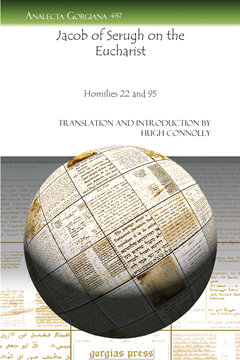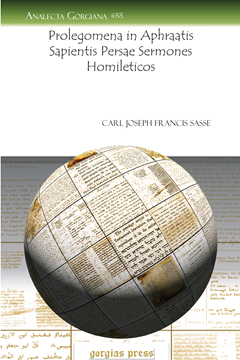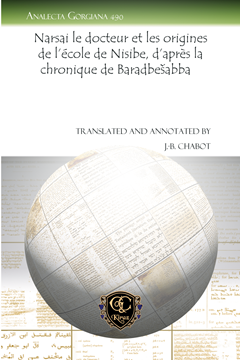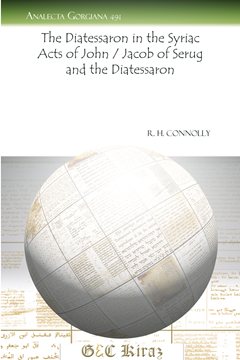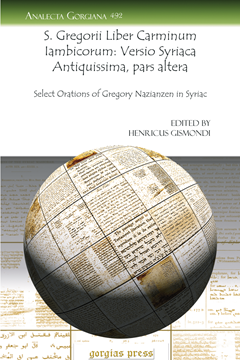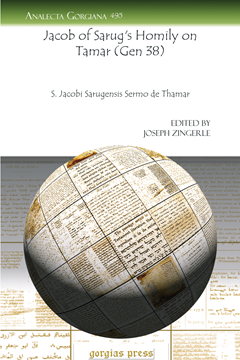Des Isho'dad von Maru Kommentar zum Hohenlied
Edited and Translated by Sebastian Euringer
Series: Analecta Gorgiana 476
ISBN: 978-1-60724-944-3
Sebastian Euringer publishes here the Syriac text of Isho’dad of Merv’s commentary on the Song of Songs accompanied by an introduction, a German translation of the commentary, notes on the translation, and parallels from other commentaries.
$36.00 (USD)
Die zwölf Marka-Hymnen aus dem "Defter" der samaritanischen Liturgie
Translation and Introduction by Paul Kahle
Series: Analecta Gorgiana 477
ISBN: 978-1-60724-945-0
Paul Kahle publishes here a German translation, with critical notations, of twelve Aramaic Marka hymns, which are an important piece in the early Samaritan liturgy. Kahle’s work supplements other works that contain the Aramaic texts by providing a modern translation.
$37.00 (USD)
Die äthiopische Überlieferung der Abhandlung des Evagrius "Über die acht Gedanken"
Edited with an Introduction by Otto Spies
Series: Analecta Gorgiana 478
ISBN: 978-1-60724-946-7
Otto Spies publishes here a critical apparatus with variant readings to supplement Johannes Bachmann’s edition of the Ethiopic version of the work “concerning the eight [sinful] thoughts” by Evagrius of Pontus. Spies provides a German translation of the collated text.
$36.00 (USD)
Die Regenbitten Aphrems des Syrers
Ihre Überlieferung unter besonderer Berücksichtigung des nestorianischen Officiums der Ninivitenasten und ihre religionsgeschichtliche Bedeutung
By Paul Krüger
Series: Analecta Gorgiana 479
ISBN: 978-1-60724-947-4
Paul Krüger discusses the influence of the “rain prayer” of Ephrem by tracing its use throughout several stages in the development of the Syriac liturgical traditions.
$43.00 (USD)
105 Zitierte Psalmenübersetzung
Series: Analecta Gorgiana 480
ISBN: 978-1-60724-948-1
The Syriac tradition played an important role in shaping pre- and early Islamic concepts of Christianity. In this article, Anton Baumstark argues that a few Arabic citations of the Bible reflect reliance on Old Syriac translations rather than the Peshitta.
$36.00 (USD)
Eine Homilie des Ampiliochius von Iconium über Basilus von Cäsarea
Translation and Introduction by K.V. Zettersteen
Series: Analecta Gorgiana 481
ISBN: 978-1-60724-949-8
K.V. Zettersteen publishes here a German translation of a homily of which he had previously published separately the Syriac text. The homily is attributed to Amphilochius of Iconium and it serves as a biography of Basil the Great.
$38.00 (USD)
Orientalisches in altspanischer Liturgie
Series: Analecta Gorgiana 482
ISBN: 978-1-60724-950-4
Anton Baumstark compares elements of the “old-Spanish” or Mozarabic liturgy with eastern liturgies in order to demonstrate an “oriental” influence.
$39.00 (USD)
Ein arabisches Poententiale bei den Kopten
Translation and Introduction by Georg Graf
Series: Analecta Gorgiana 483
ISBN: 978-1-60724-951-1
Georg Graf publishes a German translation, accompanied by translation notes, of an Arabic poenitentiale text that is a collection of previous material. Graf also provides an introduction to the text in which he discusses source materials and their relationship.
$36.00 (USD)
Jews, Christians and Zoroastrians
Religious Dynamics in a Sasanian Context
Edited by Geoffrey Herman
Series: Judaism in Context 17
ISBN: 978-1-4632-0250-7
The Sasanian Empire was home to many religious communities. It was also a place of meeting and transformation. The studies in this volume encompass a diverse array of topics concerning these religious communities inhabiting the Sasanian Empire. Some include the Roman East in their deliberations. Most, however, deal with the interaction of one or other religious community based in the Sasanian Empire with the dominant religion of the empire, Zoroastrianism.
$163.00 (USD)
Aphrahat's Demonstrations 2 and 7
On Love, and On Penitents
Translated by Frank Hallock
Series: Analecta Gorgiana 484
ISBN: 978-1-60724-952-8
This volume reproduces translations of Aphrahat’s 2nd and 7th Demonstrations into English. The texts cover themes including Law and Gospel, salvation history, commandments to love and forgive, repentance, Jesus as physician, and pastoral care.
$38.00 (USD)
Isaac of Antioch's Homily on the Royal City
Edited and Translated by C. Moss
Series: Analecta Gorgiana 485
ISBN: 978-1-60724-953-5
In this volume, Moss gives an introduction, edition, and annotated translation of an important poem (in the seven-syllable meter) from Isaac of Antioch on the Huns’ attack on Constantinople in the 440s.
$38.00 (USD)
Ueber und aus Reden von zwei syrischen Kirchenvätern über das Leiden Jesu
Translation and Introduction by Pius Zingerle
Series: Analecta Gorgiana 486
ISBN: 978-1-60724-954-2
In these two articles, Zingerle surveys, in German, fourteen poems from Isaac of Antioch and Jacob of Sarug. His aim is to look at how two different Syriac authors expound the same theme: the events surrounding Jesus’ crucifixion.
$41.00 (USD)
Jacob of Serugh on the Eucharist
Homilies 22 and 95
Translation and Introduction by Hugh Connolly
Series: Analecta Gorgiana 487
ISBN: 978-1-60724-955-9
In the two articles reprinted here, Dom Hugh Connolly offers an annotated English translation of two homilies from Jacob of Serugh dealing with the Eucharist (Bedjan nos. 22 and 95), as well as a short selection from homily 53.
$39.00 (USD)
The Third Part of the Ecclesiastical History of John, Bishop of Ephesus
Now First Translated from the Original Syriac
Translation and Introduction by Robert Payne Smith
Series: Syriac Studies Library 62
ISBN: 978-1-60724-961-0
Payne Smith gives an English translation of part of John of Ephesus’ Ecclesiastical History, which does not survive complete. It is one of the most significant texts for studying church history in the later sixth century in the east.
$213.00 (USD)
Essai de vulgarisation des homélies métriques de Jacques de Saroug
Translated by Jacques Babakhan
Series: Syriac Studies Library 64
ISBN: 978-1-60724-963-4
In this series of articles originally published in Revue de l’Orient Chrétien from 1912-1914, Babakhan aimed to popularize the work of Jacob of Sarug. Included are rhymed French translations of extracts from five of Jacob’s homilies.
$120.00 (USD)
Syrische Wechsellieder von Narses
Ein Beitrag zur altchristlichen syrischen Hymnologie
Edited and Translated by Franz Feldman
Series: Syriac Studies Library 65
ISBN: 978-1-60724-964-1
In this volume, Feldman gives the Syriac text of eight dialogue poems (sogyatha) by Narsai together with a German translation; various biblical narratives are presented, as well as dialogues between Cyril and Nestorius, and the Persian king and some martyrs.
$118.00 (USD)
Patrum Nicaenorum Nomina Latine Graece Coptice Syriace Arabice Armeniace
Series: Syriac Studies Library 66
ISBN: 978-1-60724-965-8
This important reference work contains the lists of those bishops that attended the Council of Nicaea according to manuscripts preserved in Latin, Greek, Coptic, Syriac, Arabic, and Armenian. The non-Latin and Greek lists are translated, and indexes are included.
$182.00 (USD)
Prolegomena in Aphraatis Sapientis Persae Sermones Homileticos
Series: Analecta Gorgiana 488
ISBN: 978-1-60724-966-5
Sasse’s foundational study of the early Syriac author Aphrahat is divided into three sections: Aphrahat’s life, his writings (including a study of the Armenian translation), and his biblical citations in comparison with the Peshitta.
$41.00 (USD)
Die Haggadischen Elemente in den Homilien des Aphraates, des persischen Weisen
By Salomon Funk
Series: Analecta Gorgiana 489
ISBN: 978-1-60724-967-2
In this volume, Funk addresses questions concerning Aphrahat’s possible relationship to Jewish sources. His method in the main part is to go through biblical passages that Aphrahat comments on and show parallels with rabbinic literature.
$47.00 (USD)
Narsai le docteur et les origines de l'école de Nisibe, d'après la chronique de Barḥadbešabba
Translated and Annotated by J.-B. Chabot
Series: Analecta Gorgiana 490
ISBN: 978-1-60724-968-9
This volume contains Chabot’s notice of a fragment published by Mingana from Barhadbeshabba dealing with Narsai and the School of Nisibis. Chabot offers a French translation of the text and a summary questioning its historical value.
$36.00 (USD)
The Diatessaron in the Syriac Acts of John / Jacob of Serug and the Diatessaron
Series: Analecta Gorgiana 491
ISBN: 978-1-60724-969-6
This volume contains two short studies on the Diatessaron and Syriac literature. Readers who study the history of the Gospels in Syriac and their reception and use in Syriac literature will find these two studies of interest.
$39.00 (USD)
Versio Syriaca Antiquissima, pars altera
Select Orations of Gregory Nazianzen in Syriac
Edited by Henricus Gismondi
Series: Analecta Gorgiana 492
ISBN: 978-1-60724-970-2
This volume contains Syriac texts of the old Syriac translation of Gregory Nazianzen’s orations edited from British Museum manuscripts. Fourteen orations, in whole or in part, are included, with concordance of the texts with Migne’s Patrologia Graeca edition.
$49.00 (USD)
Das zweite Josephs-Gedicht von Narses
Edited with an Introduction by Max Weyl
Series: Analecta Gorgiana 493
ISBN: 978-1-60724-971-9
This volume, Weyl’s inaugural dissertation, contains the critical edition of Narsai’s second poem on Joseph (from Genesis), edited from two Berlin manuscripts, along with several pages of philological annotations to the text.
$48.00 (USD)
Die Geschichte Josefs von Mar Narses
Edited and Translated by Victor Grabowski
Series: Analecta Gorgiana 494
ISBN: 978-1-60724-972-6
This volume contains an edition, with annotated translation, of one of Narsai’s poems on the Joseph story from Genesis.
$40.00 (USD)
Jacob of Sarug's Homily on Tamar (Gen 38)
S. Jacobi Sarugensis Sermo de Thamar
Edited by Joseph Zingerle
Series: Analecta Gorgiana 495
ISBN: 978-1-60724-973-3
This small volume contains an edition (from Vatican ms. 117) of Jacob of Sarug’s homily “On Tamar and on the Mystery of the Church.”
$38.00 (USD)
